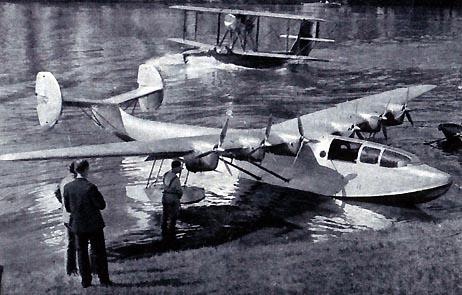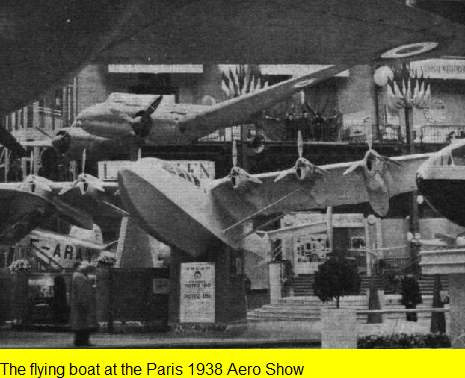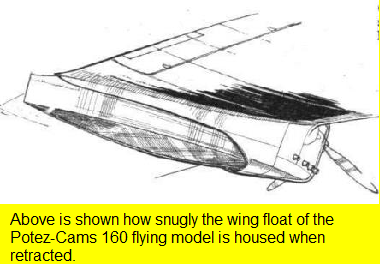In 1936 the northern French factories of Potez and of the
seaplane maker CAMS, the latter owned by Potez since 1932,
were nationalized along with those of Amiot, Breguet and
ANF Mureaux into SNCAN. In the same year the design bureau
of Potez-CAMS was beginning the development of the
Potez-CAMS 161 six engine, trans-Atlantic passenger flying
boat, intended to be a key component of Air France's
Transatlantique fleet. To test the design they built a 5/13 scale
flying scale model of it, careful not just to scale dimensions of
the flying surfaces and hull, but also to copy the form the nose
around the cabin, engine cowlings and retractable float housings.
Control surface detail and the flaps of the 161 together with its
variable-pitch propellers, were included on the resulting
Potez-CAMS 160. It was intended to prove both the aerodynamic
and hydrodynamic behaviour of the airliner.It flew for the first time on 20 June 1938
The 160 was a high-wing monoplane. The wing was a semi-cantilever structure, with two parallel bracing struts on each side from the lower fuselage to the wing just inside the central engines, straight-edged in plan with taper on the trailing edge only and rounded tips. It was fitted with interconnected Handley Page slots and ailerons as well as split flaps. It was powered by six four-cylinder inverted inline air-cooled Train 4T engines, each producing 30 kW (40 hp) driving three blade, variable-pitch propellers. The engines were mounted on the wing underside, housed in long, narrow cowlings intended to mimic those around the 664 kW (890 hp) Hispano-Suiza 12Ydrs water-cooled V-12 engines of the full scale aircraft.
The little flying boat had a conventional stepped hull and was stabilized on the water by a pair of floats, attached under the outboard engines and retracting into their cowlings. Its enclosed, tandem seat cockpit was shaped to reproduced the form of the 161's nose, though the full sized aircraft had proportionally shorter glazing. The 161 had a twin fin empennage with a N-strut braced, parallel chord tailplane mounted on top of the fuselage on a short pillar with marked dihedral. The fins were of the endplate type, with curved leading edges and roughly symmetric above and below the tailplane; on each, the rudder was split into an upper and lower part. All of these features appeared on the final, full size airliner.
The Potez-CAMS 160 appeared, after its first flight, at the 1938 Paris Aero Show.
| Type |
2-seat experimental flying boat |
| Engine |
6 Train 4A-01 (40 hp at 2300 rpm) 3-bladed metal Ratier variable pitch dia 1,50 m |
| Dimensions |
Length 12,37 m, height 3,41 m , span 17,69 m , wing area 38,70 m2 ,wing chord 2,69 m at the rectangular part |
| Weights |
Empty , loaded 2275 kg , max. take off weight |
| Performance |
Max.. speed 222 km/h at 950 m, cruising speed , range , endurance , service ceiling , climb |
| Type |
Werk.Nr |
Registration |
History |
|
|
PG+ID |
First flight 20 March 1938, pilot Maurice Hurel |



